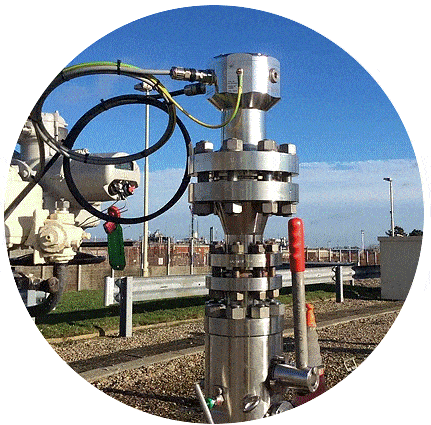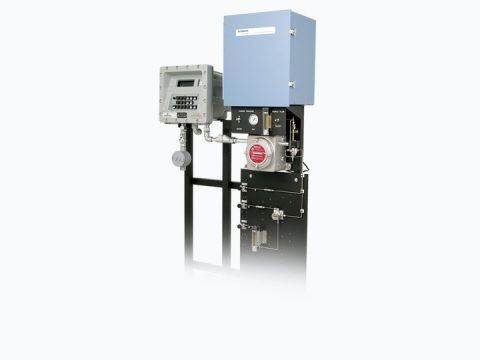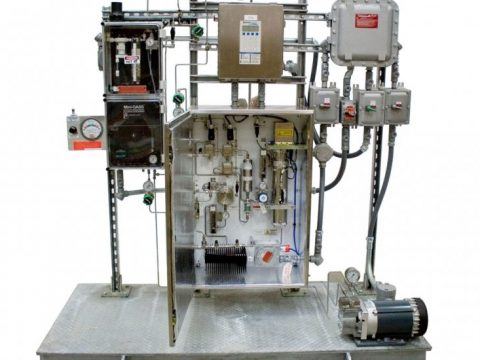LineVu – Pipeline Flow Video Capture
LineVu | A New Way of Thinking
Detection of Pipeline Contamination using Image Processing
When natural gas is processed, liquids are injected to remove water vapor, carbon dioxide and hydrogen sulfide. It is vital that these liquids are completely removed from the gas stream prior to exporting the gas for sale yet, to date, there are no effective methods to determine if liquid separators are working to their stated efficiency 100% of the time. Often operators find out too late that there is a problem with liquid carry over causing $Ms of damage.
If hydrocarbon liquids are allowed to enter dehydration systems, foaming can occur requiring the addition of de-foaming agents. At the exit of the de-hydration system, liquids like glycol (MEG and TEG), crawl down the walls of the pipeline causing further problems.
If the processing plant is fitted with a refrigeration (or dew pointing) system to remove as much, high value, gas condensate as possible, glycol enters the system and freezes at around -6°C, causing problems with the temperature control of the system and further liquids remain in the export gas stream.
“Gas analyzers are specifically designed to avoid and filter out liquids.”
Apart from the safety issues, gas sale contracts usually specify that no liquids (or solids) should be present. If breaches of the contract are proved, buyers can decide to reject the supply until the process upset is resolved or re-negotiate the price. In some cases, a hefty fine from the buyer or pipeline operator will also add to costs.
Gas contracts strictly specify the gas quality and require there to be no liquids, with good reason. If allowed into the gas network, liquids can build up in low spots and corrode the internal pipe wall as happen in Carlsbad, New Mexico.
In gas processing plants and refineries there are often absorber beds or catalysts that are sensitive to liquids. There have been many instances where liquids have been allowed to carry-over into the gas stream and damage catalyst or absorbent.
LineVu
We believe that process supervisors and operations teams should have the best information possible in order to make the best operational decisions.
LineVu provides an alarm when the following contamination is detected:
-
Liquids
-
Hydrates
-
Foam
Under normal dry gas conditions, the system will see no movement (even though the gas may be moving at around 30 mph). A permanent video stream of pipeline activity is available to view at any time. In the event of contamination, image processing delivers an alarm. This offers a significant step forward in process assurance for critical applications.
LineVu is a very powerful tool for diagnostics, and provides evidence of events where tariff agreements have been broken and justification is needed to support a decision to temporarily stop the supply, or support a compensation claim from the gas supplier.
Using existing tapping points LineVu can be installed at custody transfer points, or at the entry to, or exit from, critical gas processing systems, providing indisputable evidence of contamination events.
Greater process confidence is gained when operators can see events in high pressure systems. A live video feed of pipeline activity is available at any time via a standard web browser. An alarm (volt free relay) is raised when contamination is detected, and LineVu automatically starts recording data at that point. It continues to record until no further contamination is detected. Time, date and location are burnt onto the video image so that, during event playback, all relevant process data are played back alongside the video and provides a complete picture of the event to aid fault diagnosis.
Time, date and location are burnt onto the video image along with process data from the client such as gas flow rate, line pressure, position of critical valves and other relevant details can be displayed and recorded alongside the video so that during event playback all relevant process data are played back alongside the video and provides a complete picture of the event to aid fault diagnosis.
A New Way of Thinking
After safety considerations, ease of installation and commissioning are of great importance. LineVu does not require sections of pipe to be removed or pits to be dug. It is mounted above the pipeline, using existing 2” or 3” tapping points wherever possible, behind a double block and bleed valve. A small stand-off flange adapter is used between the valve and the LineVu Camera Can. This stand-off from the main pipeline avoids contamination landing on the optical windows (capable of up to 200 Bar working pressure) of the Camera Can.
A variety of illumination techniques can be used depending upon the type of contamination that is seen.
Data may be stored in the rack mount PC or on the client’s network. Still shots may be taken for entry into reports or sent via SMS texts to interested parties. Video may be uploaded for remote access and service engineers or customers to view to improve response to an event.
Safety
Safety is a key feature. LineVu is permanently installed on a pipeline or high pressure vessel. Using a standard tapping point, it is mounted behind a double block and bleed valve. All windows and internal seals are designed to withstand up to 15,000 psi (1000 Bar). Independent LOPA and FMEA studies confirm that the secondary containment system provides sufficient levels of safety for pipeline network installation.
Benefits
Buyers: At custody transfer points buyers can make better decisions.
With firm evidence they can:
-
decide the acceptability of the supply
-
correct flow meter reading for wet gas
-
make the supplier accountable
-
re-negotiate costs
-
lower legal costs
Suppliers: At export gas line points suppliers can reduce downtime.
With better information they can:
-
quickly determine the severity of the process failure
-
improve operational decisions
-
lower risk of financial penalties
-
provide proof of dry gas
Asset Integrity Managers:
With LineVu in place, asset integrity managers can:
-
lower the risk of hydrate blockages
-
decrease the requirement for pigging




